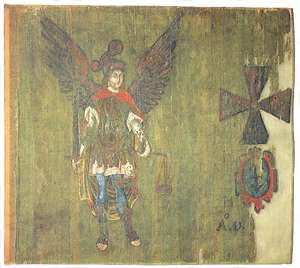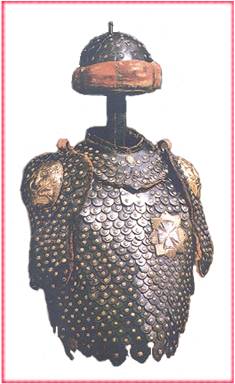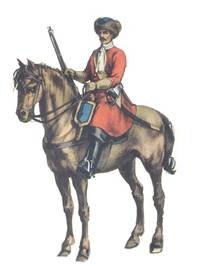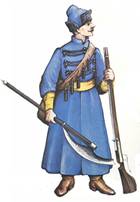|

Second Half of 15th Century
First
Half of 16th Century
Second
Half of 16th Century
First
Half of 17th Century
Reforms
of 1632-1633
Second
Half of 17th Century
The
end of 17th Century
|
 |
The Second Half of the 17th Century
The cavalry
 During
Wladyslaw IV's reign cavalry banners, of different troop types,
were formed into regiments as larger tactical units. Often four
banners together, hussars with light or medium cavalry. During
Wladyslaw IV's reign cavalry banners, of different troop types,
were formed into regiments as larger tactical units. Often four
banners together, hussars with light or medium cavalry.
During the critical years 1655-62 the numbers of
hussars fell to a mere 5-7% while the numbers of light cavalry grew
to a rather large proportion. This was because of the ease of raising
such typically Polish cavalry from the large noble population (the
nobility formed some 10% of Poland's population). It was essentially
a medieval and informal type of call up and did not need the high
capital outlay of the infantry and hussars (ie. training, equipment,
supplies etc). Because of this the numbers of light cavalry were
later restricted and by Sobieski's reign they were fixed as a maximum
of 20% of the cavalry, with pancerni at 60% and hussars the remaining
20%. Regiments of cavalry were formed in the ratio of one hussar
banner to three pancerni, while the light cavalry were formed into
regiments of their own, though sometimes with a pancerni banner.
 The
pancerni and light cavalry often used lances, 2.5-3.5m long, and
after 1677 they all carried them. With the hussars being a much
smaller proportion of the army compared to during the reign of Wladyslaw,
the pancerni became the main heavy cavalry. The pancerni were a
very flexible force suitable for a wide variety of roles. The light
cavalry were used for reconnaissance, pursuit and harassment. All
the cavalry carried pistols and most had bows and muskets although
their chief method of fighting was with drawn sabres and lances. The
pancerni and light cavalry often used lances, 2.5-3.5m long, and
after 1677 they all carried them. With the hussars being a much
smaller proportion of the army compared to during the reign of Wladyslaw,
the pancerni became the main heavy cavalry. The pancerni were a
very flexible force suitable for a wide variety of roles. The light
cavalry were used for reconnaissance, pursuit and harassment. All
the cavalry carried pistols and most had bows and muskets although
their chief method of fighting was with drawn sabres and lances.
The hussars remained much the same as in Wladyslaw's
reign although they now only charged in two ranks. However they
began to dress more elaborately and there was a fad for wearing
"karacena" armour, which was a type of scale armour. It was said
that if the sky fell the hussars' lances would support it, while
Maurice de Saxe, the French marshal and military writer proposed
the creation of a French cavalry modelled on the hussars.
The infantry
There were three types of infantry;- Polish-Hungarian, "foreign
section" and dragoons and table 1 below shows their relative proportions
during the period 1633 to 1698. Wladyslaw had formed a modern and
independent infantry arm with his reorganisation of the army and
from then on the infantry formed around 50% of the army and often
up to 60%. Although this is not as high as in Western European armies,
this is because of Poland's different circumstances - large open
borders to the east.
Polish-Hungarian infantry:
These troops altered little during this period. In the 1660's they
changed from their nine or ten rank formation to a six rank one.
They were usually recruited from the Southern provinces and real
Hungarians were rare. They appeared only in small numbers and usually
stood at the Hetman's side. In battle they were usually placed behind
the tabor or fortifications and they often formed garrisons in forts.
Modelled on theses units were formed units of Cossacks, although
they were  mainly
found in private armies. In the 1680's and 90's there appeared units
of Janissaries, ie. Polish infantry in janissary style dress and
armed with musket and sword. They typically formed body guard units. mainly
found in private armies. In the 1680's and 90's there appeared units
of Janissaries, ie. Polish infantry in janissary style dress and
armed with musket and sword. They typically formed body guard units.
Dragoons:
Dragoons were widely employed especially in the open plains of the
South where mobility was so important. They remained mounted infantry
up until the late 17th century. Dragoon units varied from 200-600
men, although some, such as Czarniecki's, Bockuma's and Potocki's
regiments, were up to 1,000 men strong. They carried lighter muskets
than the infantry as well as sabres and axes. The dragoons were
Sobieski's favourite troops and he often wore their uniform, he
also sometimes led them on foot into battle,  such
as at Chocim (1673). such
as at Chocim (1673).
"Foreign" infantry:
The large regiments of Wladyslaw IV's period, 1,000-1,600 paper
strength in 8-10 companies reduced by 1660's to smaller ones with
600 paper strength, 500 actual in 6 or less companies. The smaller
regiments were formed into brigades of 2-3 regiments. At first the
"foreign" infantry wore German or Swedish style dress and were in
the main officered by Germans, although the bulk of the troops were
Polish. By the 1660's most of the officers were Poles and the uniforms
also altered so that by the 1670's most "foreign" troops wore Polish
style dress. Pikeman's armour disappeared in the late 1650's. They
were armed with Dutch muskets, or pikes (ratio 2:1) and rapiers
or sabres. In the early 1670's the infantry began to use axes, which
were used as a melee weapon, a musket rest and also for the construction
of field defences. The length of these axes is not known (the one
in the Warsaw Polish army museum seems rather short), but we can
assume that their haft was as long as a musket rest (that is at
least 1.2 metres), it was carried on a belt and slung over the shoulder.
It replaced the musket rest and later also the sabre, however there
is no proof it replaced the pike. Although it seems likely the numbers
of pikemen was reduced they were still used up until the introduction
of the flintlock and bayonet (which began in the 1690's). Grenades
became popular and were to be found in large quantities in late
17th Century forts and arsenals, although their use was mainly restricted
to sieges. Laskowski mentions Sobieski's introduction of grenadiers
in 1667. The infantry's tactics remained similar to those employed
by other pike and shot infantry, though from the 1670's their offensive
capability was improved with the introduction of axes. Sobieski
also introduced the firing of salvos only after the enemy had fired
theirs and then charging into contact. They stood in linear formations
to maximise firepower, although it seems their battlefield formations
were deeper than in Western Europe (to allow the strengthening of
the first line with successive lines of fresh troops. In defence
they often made use of field defences, especially earthworks as
a defence against artillery and cavalry.
 From
Wladyslaw's period to Sobieski's the "foreign" infantry was inferior
to the Swedish or Dutch infantry, but at least equal to the German
infantry. It was superior to Turkish infantry, who lost formation
easily, and Muscovite infantry , who though they attempted to follow
the western model had little success. The Polish infantry were described,
that though in rags they had an incomprehensible doggedness. After
the deluge they were, together with the hussars, amongst the most
disciplined troops in the Polish army. Dalerac who saw the Polish
army during the Vienna campaign wrote "infantry in Poland is generally
in a miserable state, worse even then in Spain and Italy. Some are
in hats, some in fur caps, some with coats and some without. They
lack swords but have two handed axes, which seems to me they use
superbly. Soldiers wear the axes slung on their shoulder across
their back. Although dressed appallingly these soldiers are indescribably
brave, withstanding many hardships, hunger, cold and beatings" From
Wladyslaw's period to Sobieski's the "foreign" infantry was inferior
to the Swedish or Dutch infantry, but at least equal to the German
infantry. It was superior to Turkish infantry, who lost formation
easily, and Muscovite infantry , who though they attempted to follow
the western model had little success. The Polish infantry were described,
that though in rags they had an incomprehensible doggedness. After
the deluge they were, together with the hussars, amongst the most
disciplined troops in the Polish army. Dalerac who saw the Polish
army during the Vienna campaign wrote "infantry in Poland is generally
in a miserable state, worse even then in Spain and Italy. Some are
in hats, some in fur caps, some with coats and some without. They
lack swords but have two handed axes, which seems to me they use
superbly. Soldiers wear the axes slung on their shoulder across
their back. Although dressed appallingly these soldiers are indescribably
brave, withstanding many hardships, hunger, cold and beatings"
Table 1: Proportions of Infantry Types
|
YEAR
|
FOREIGN
|
POLISH
|
DRAGOONS
|
NOTES |
|
1633
|
65%
|
20%
|
15%
|
All mercenaries |
|
1634
|
58%
|
22%
|
20%
|
At Kamieniec, large number of private
troops |
|
1635
|
77%
|
11%
|
12%
|
Against the Swedes in Pomeria |
|
1648
|
9%
|
17%
|
74%
|
Peacetime force (not including guard)
|
|
1649
|
55%
|
8%
|
37%
|
During campaign |
|
1650
|
56%
|
10%
|
35%
|
Peacetime force |
|
1651
|
66%
|
11%
|
23%
|
During campaign |
|
1652
|
60%
|
18%
|
22%
|
At Batoh |
|
1655
|
57%
|
15%
|
28%
|
Before the Swedish invasion |
|
1656
|
56%
|
14%
|
30%
|
During campaign |
|
1659
|
54%
|
5%
|
40%
|
Maximum size of the army |
|
1663
|
70%
|
5%
|
25%
|
|
|
1667
|
73%
|
5%
|
22%
|
Peacetime force |
|
1673
|
59%
|
3%
|
38%
|
During campaign |
|
1676
|
73%
|
4%
|
23%
|
After re-organisation |
|
1677
|
68%
|
7%
|
25%
|
Peacetime force |
|
1683
|
73%
|
3%
|
24%
|
Wartime force |
|
1685
|
74%
|
4%
|
22%
|
After reorganisation |
|
1690
|
71%
|
5%
|
24%
|
After reduction of the army |
|
1698
|
75%
|
5%
|
20%
|
During campaign |
Source:- Historia Piechoty
Polskiej Do Roku 1864, by Jan Wimmer (rounded to whole percentages)
The artillery
The ample artillery of Wladyslaw IV's era was largely lost in the
defeats of Korsun, Pilawa and Batoh, by 1654 it had been rebuilt
to some 600 cannons, but again most was lost, this time during the
Swedish invasion. It was only partly rebuilt afterwards and did
not reach its earlier large numbers during our period.
The level of training and direction of the artillery
was and remained relatively high. Units of infantry and dragoons
were specifically organised to protect the artillery, especially
during marches. In 1673 a separate regiment was formed, under the
command of the General of the artillery, whose role was to protect
the artillery.
Fortifications were greatly rebuilt and improved
during Wladyslaw IV's reign and field defences played an increasingly
valuable part of Polish battle tactics (especially when facing overwhelming
enemy forces). However the deluge caused a great deal of damage
to fortifications and Poland's bare treasury meant a decline in
fortification building and improvements. By 1661 the army could
not afford to besiege any eastern fortresses, though it still knew
that "the cannon ensures the strength
of a fortress and the fortress fears the cannon most of all"(A.M.
Fredro).
 6
6 
|
|

Page 6
|

![]()
 During
Wladyslaw IV's reign cavalry banners, of different troop types,
were formed into regiments as larger tactical units. Often four
banners together, hussars with light or medium cavalry.
During
Wladyslaw IV's reign cavalry banners, of different troop types,
were formed into regiments as larger tactical units. Often four
banners together, hussars with light or medium cavalry.  The
pancerni and light cavalry often used lances, 2.5-3.5m long, and
after 1677 they all carried them. With the hussars being a much
smaller proportion of the army compared to during the reign of Wladyslaw,
the pancerni became the main heavy cavalry. The pancerni were a
very flexible force suitable for a wide variety of roles. The light
cavalry were used for reconnaissance, pursuit and harassment. All
the cavalry carried pistols and most had bows and muskets although
their chief method of fighting was with drawn sabres and lances.
The
pancerni and light cavalry often used lances, 2.5-3.5m long, and
after 1677 they all carried them. With the hussars being a much
smaller proportion of the army compared to during the reign of Wladyslaw,
the pancerni became the main heavy cavalry. The pancerni were a
very flexible force suitable for a wide variety of roles. The light
cavalry were used for reconnaissance, pursuit and harassment. All
the cavalry carried pistols and most had bows and muskets although
their chief method of fighting was with drawn sabres and lances.

 such
as at Chocim (1673).
such
as at Chocim (1673).  From
Wladyslaw's period to Sobieski's the "foreign" infantry was inferior
to the Swedish or Dutch infantry, but at least equal to the German
infantry. It was superior to Turkish infantry, who lost formation
easily, and Muscovite infantry , who though they attempted to follow
the western model had little success. The Polish infantry were described,
that though in rags they had an incomprehensible doggedness. After
the deluge they were, together with the hussars, amongst the most
disciplined troops in the Polish army. Dalerac who saw the Polish
army during the Vienna campaign wrote "infantry in Poland is generally
in a miserable state, worse even then in Spain and Italy. Some are
in hats, some in fur caps, some with coats and some without. They
lack swords but have two handed axes, which seems to me they use
superbly. Soldiers wear the axes slung on their shoulder across
their back. Although dressed appallingly these soldiers are indescribably
brave, withstanding many hardships, hunger, cold and beatings"
From
Wladyslaw's period to Sobieski's the "foreign" infantry was inferior
to the Swedish or Dutch infantry, but at least equal to the German
infantry. It was superior to Turkish infantry, who lost formation
easily, and Muscovite infantry , who though they attempted to follow
the western model had little success. The Polish infantry were described,
that though in rags they had an incomprehensible doggedness. After
the deluge they were, together with the hussars, amongst the most
disciplined troops in the Polish army. Dalerac who saw the Polish
army during the Vienna campaign wrote "infantry in Poland is generally
in a miserable state, worse even then in Spain and Italy. Some are
in hats, some in fur caps, some with coats and some without. They
lack swords but have two handed axes, which seems to me they use
superbly. Soldiers wear the axes slung on their shoulder across
their back. Although dressed appallingly these soldiers are indescribably
brave, withstanding many hardships, hunger, cold and beatings"